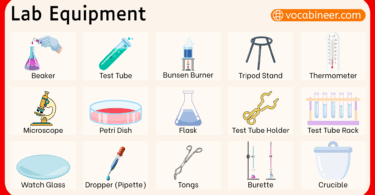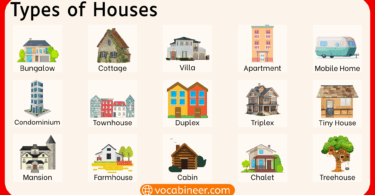Learning metal names in English helps students and ESL learners build better vocabulary for science, tools, and everyday objects. From shiny metals like gold and silver to useful ones like iron and aluminum, this list connects each name with a picture to make learning easier. By studying 50 metal names with pictures, learners can improve spelling, remember groups of metals, and talk about materials clearly in English.
In This Page
List of All Types of Metals with Symbols and Pictures
Here is a complete list of different types of metals with their symbols and pictures. This helps students learn metal names, how they are written in science, and what they look like.
- Iron – Fe
- Copper – Cu
- Aluminum – Al
- Zinc – Zn
- Tin – Sn
- Lead – Pb
- Nickel – Ni
- Chromium – Cr
- Manganese – Mn
- Cobalt – Co
- Gold – Au
- Silver – Ag
- Platinum – Pt
- Palladium – Pd
- Rhodium – Rh
- Iridium – Ir
- Lithium – Li
- Sodium – Na
- Potassium – K
- Rubidium – Rb
- Cesium – Cs
- Francium – Fr
- Beryllium – Be
- Magnesium – Mg
- Calcium – Ca
- Strontium – Sr
- Barium – Ba
- Radium – Ra
- Titanium – Ti
- Vanadium – V
- Molybdenum – Mo
- Tungsten – W
- Zirconium – Zr
- Scandium – Sc
- Hafnium – Hf
- Tantalum – Ta
- Rhenium – Re
- Osmium – Os
- Arsenic – As
- Antimony – Sb
- Bismuth – Bi
- Tellurium – Te

Ferrous and Non-Ferrous Metals Name in English
Understanding the two basic groups of metals helps in sorting their everyday uses.
- Iron – A strong ferrous metal used in tools and construction.
- Steel – An alloy made mainly from iron, used in buildings and machines.
- Cast Iron – A heavy ferrous metal used in cookware and pipes.
- Wrought Iron – Malleable and decorative, often used in fences.
- Copper – A reddish non-ferrous metal used in wires and plumbing.
- Aluminum – Lightweight and rust-free, used in cans and transport.
- Brass – A copper-zinc alloy used in musical instruments.
- Bronze – A copper-tin mix used in statues and medals.
- Lead – A heavy non-ferrous metal used in batteries and shielding.
- Zinc – Used to coat steel and prevent rusting (galvanizing).
Precious and Rare Metal Names with Images
These metals are valued for their beauty, rarity, and industrial roles.
- Gold – Soft and shiny, used in jewelry, coins, and electronics.
- Silver – Bright and conductive, common in jewelry and mirrors.
- Platinum – Durable and rare, used in catalytic converters and rings.
- Palladium – A high-value metal used in electronics and dentistry.
- Rhodium – Extremely rare, used in mirrors and car exhaust systems.
- Iridium – Very dense, used in scientific equipment.
- Osmium – A bluish metal used in fountain pen tips.
Heavy and Light Metals Vocabulary for Students
Knowing the weight and density helps in understanding metal applications.
Heavy Metals
- Mercury – Liquid at room temperature, used in thermometers.
- Tungsten – High melting point, used in bulbs and drills.
- Bismuth – Non-toxic heavy metal, used in cosmetics and medicine.
Light Metals
- Aluminum – Common in foil and soda cans.
- Magnesium – Light and strong, used in bikes and cameras.
- Titanium – Lightweight yet tough, used in aircraft and implants.
Names of Reactive and Alkali Metals with Examples
These metals react easily, especially with water and air.
- Sodium – Soft and highly reactive, used in streetlights.
- Potassium – Reacts with water, essential in fertilizers.
- Lithium – Used in rechargeable batteries.
- Calcium – Found in bones and used in construction (lime).
- Barium – Used in medical imaging.
- Strontium – Produces red flames in fireworks.
Transition and Post-Transition Metal Elements in English
These metals are often strong and form colorful compounds.
Transition Metals
- Iron
- Copper
- Nickel
- Zinc
- Chromium
Post-Transition Metals
- Lead
- Tin
- Bismuth
- Aluminum
- Gallium
Industrial and Structural Metals Used in Daily Life
These are essential in construction, tools, and infrastructure.
- Steel – Beams, bridges, and cars.
- Iron – Railings, engines, and cookware.
- Copper – Pipes, cables, and motors.
- Aluminum – Windows, utensils, and airplanes.
- Zinc – Roofing and protective coatings.
- Nickel – Used in stainless steel and batteries.
List of Metals Used in Jewelry and Electronics
Some metals are popular for beauty, while others power devices.
Jewelry
- Gold
- Silver
- Platinum
- Rhodium
Electronics
- Copper – Wires and circuit boards.
- Tin – Soldering components.
- Lithium – Battery cells.
- Gold – Connectors and processors.
- Tantalum – Capacitors in smartphones.
Radioactive and Toxic Metal Types
These metals require care and control due to their hazards.
Radioactive Metals
- Uranium – Used in nuclear fuel.
- Plutonium – Found in nuclear weapons and reactors.
- Thorium – Used in experimental reactors.
Toxic Metals
- Lead – Dangerous in old paints and pipes.
- Mercury – Harmful when inhaled or touched.
- Cadmium – Found in batteries and pigments.
FAQs About Metal Names
Metals are usually grouped into ferrous, non-ferrous, precious, alkali, and transition types.
Lithium is the lightest solid metal.
Rarity, beauty, and industrial value make metals like gold, platinum, and silver precious.
No. Some, like bismuth, are safe, while others like lead and mercury are toxic.
They’re essential in tools, buildings, vehicles, electronics, and even medicine.
Read More




